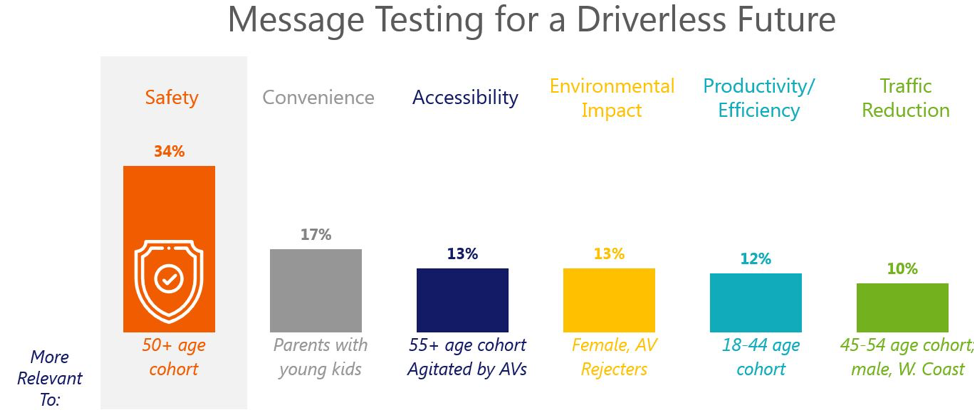Editor’s note: Chris Neal is VP, technology and telecom practice leader at research firm Chadwick Martin Bailey, Boston. This is an edited version of a post that originally appeared under the title, “Selling a driverless future: messaging strategies for the AV industry.”
Emotions play a key role in the commercial success or failure of emerging disruptive technologies. Most recently, we looked under the hood of the autonomous vehicle (AV) industry to understand the specific emotions driving or deterring widespread adoption.
On the wheels of Tesla’s recent announcement to operate a fleet of one million self-driving taxis by the end of 2020, I’ll provide more direction for how tech companies and automakers can most effectively convince various consumer segments to embrace this future.
Message testing
As part of a recent self-funded research study exploring the link between emotions and the self-driving car industry, I channeled my inner Don Draper and drafted faux ad concepts selling the promise of a driverless future.
With each concept touting a different benefit of autonomous vehicles (e.g., safety, convenience, etc.), respondents were asked to select which would most likely get them to consider a self-driving car.

Let’s dig into the results of this exercise.
Safety is unequivocally the most persuasive message – indicating a creative campaign highlighting the public health and safety benefits of widely deployed AVs may help alleviate some consumer anxiety.
People who gravitate toward the potential safety benefits tend to skew 50+ years of age and are more likely than other segments to reject the idea altogether because it makes them feel anxious and stressed. They also tend to feel more positively toward driving their own car (e.g., feeling energized, proud and in control).
Overall, productivity/efficiency isn’t a very compelling message but is more likely to appeal to Gen Z and Millennials who are often less bound to the idea of owning their own car compared to older generations.
Consumers who are drawn to these features are more likely to feel efficient, productive and smart when imagining themselves in AVs (even before they saw the messages). This is noteworthy because these specific emotions are consistently found to be key drivers to adoption in most of our emerging tech studies.
We then layered on a lift analysis that asked respondents to again consider likelihood to use an AV based on the ad message they had just selected as most compelling. Although the results from this exercise were underwhelming, I did help move some ambivalent Millennials into the full-on accepter category by touting the productivity and efficiency benefits.

As this exercise indicates – and is often the case with new tech trying to cross the chasm – marketing to the most swayable early adopters vs. general population can be an effective tactic for gaining traction. Messaging to early adopters will be more nuanced but when done right it can encourage adopters to spread positive word-of-mouth to more mainstream late adopters.
The road ahead: evolution, not revolution
The Don Drapers of the world can only do so much convincing until more people actually experience the technology for themselves.
Fortunately, consumers are getting a taste of increased levels of Advanced Driver-Assistance Systems (ADAS) technology as features like auto braking and lane correction are becoming more common in newer car models.
Further, the less common but also rapidly growing Level 3 vehicles (e.g., Tesla’s autopilot mode) that can go on full autopilot – under certain conditions – can also help consumers overcome the anxiety they have about fully letting go.
At the moment, very few consumers said they’d get into anything other than an autonomous vehicle they could – if need be – take over (i.e., Level 3). This sentiment could be problematic for the future of companies like Uber, Lyft and now Tesla, who aren’t about to let passengers take control when they feel like it.
However, people who own Level 2 or 3 vehicles have much more nuanced attitudes toward this scenario – more commonly anticipating that in the future their primary car may be Level 4 or fully autonomous at Level 5. And those who already own Level 2 or Level 3 ADAS vehicles have much stronger positive emotions and fewer intense negative emotions when reacting to being in a fully autonomous car.
Driving full circle
This leads me back to my own emotional journey with vehicular automation. Recall a run-in with a faulty cruise control back in the 1990s left me extremely wary of technical automation.
In 2018, after decades of avoiding this kind of automation, I got my first real taste of Level 2 assisted driving technology while on a road trip with my son in Washington, D.C. We were stuck in bumper-to-bumper traffic when my phone’s GPS cut out. I took my eyes off the road to futz with the phone when suddenly the car (not me) slammed on the brakes. Turns out I was about to rear-end the car in front of us.
I was shocked, embarrassed, humbled and relieved. Had it not been for the auto braking, this story would have ended differently (we were only going 30 mph, but you get the idea).
The more I see drivers face-down at the wheel, I wonder if it’s time we mere mortals start letting AI take a little more control over our transportation systems. I still have deep anxiety over the prospect of riding in a fully self-driving car, but my emotions toward this possibility are complex and evolving.
With some focused determination, those invested in these efforts can push me – and likely many others – along toward greater openness to a driverless future.
